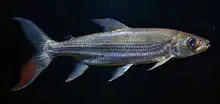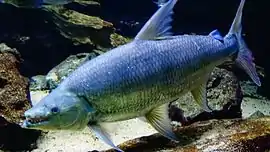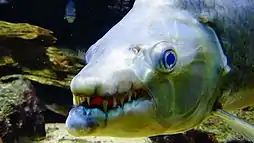Hydrocynus goliath
Hydrocynus goliath, also known as the goliath tigerfish, giant tigerfish, or mbenga, is a very large African predatory freshwater fish of the family Alestidae.
| Hydrocynus goliath | |
|---|---|
 | |
| Scientific classification | |
| Kingdom: | Animalia |
| Phylum: | Chordata |
| Class: | Actinopterygii |
| Order: | Characiformes |
| Family: | Alestidae |
| Genus: | Hydrocynus |
| Species: | H. goliath |
| Binomial name | |
| Hydrocynus goliath (Boulenger, 1898) | |
 | |
| Catchment area for Hydrocynus goliath | |
| Synonyms[2] | |
| |
Distribution
Hydrocynus goliath is found in the Congo River Basin (including Lualaba River and Lake Upemba), and Lake Tanganyika.[3] A study published in 2011 revealed several mtDNA clades in this region, suggesting a higher tigerfish species richness than traditionally recognized. If confirmed, this would restrict H. goliath to the Congo River Basin.[4] Four additional species (H. vittatus and three undescribed species) appear to be present in this Basin, while two (H. vittatus and an undescribed species) appear to be present in Lake Tanganyika.[4]
Description


This large-toothed, highly predatory fish grows to an average length of 1.5 metres (4.9 ft) and a weight of 50 kilograms (110 lb).[5] Its teeth fit into distinct grooves along its jaws. On average each of its teeth can grow up to 1 inch in accordance with biologist and television presenter Jeremy Wade.[5]
Hydrocynus goliath is the largest member of the family Alestidae. Locals near the Congo River Basin call this species M'Benga, which means "the dangerous fish" in a Swahili dialect. This species lives only in the Congo basin.[6]
Diet
Hydrocynus goliath is a piscivore, feeding on any fish it can overpower, including smaller conspecifics.
When hunting, this fish uses the calmer eddies of the rapids to ambush its prey, using its keen sight to detect prey. When a target is noticed, the fish accelerates to chase it down. The Nile crocodile is the only known predator of the goliath tigerfish.
Interaction with humans
A number of incidents have been reported in The Congo of this fish attacking humans.[7] This reputation, combined with its strength, has earned it an almost mythical status among anglers, and it has been called the "greatest freshwater gamefish in the world".[7]
According to locals living near the river, the evil spirit "Mbenga" would enter the fish and make it attack people.[8]
References
- Moelants, T. (2010). "Hydrocynus goliath". The IUCN Red List of Threatened Species. IUCN. 2010: e.T182833A7980766. doi:10.2305/IUCN.UK.2010-3.RLTS.T182833A7980766.en.
- "Synonyms of Hydrocynus goliath (Boulenger, 1898)". Fishbase. Retrieved 6 April 2017.
- Froese, Rainer and Pauly, Daniel, eds. (2013). "Hydrocynus goliath" in FishBase. April 2013 version.
- Goodier, S.A.M., F.P.D. Cotterill, C. O'Ryan, P.H. Skelton, and M.J de Wit (2011). Cryptic Diversity of African Tigerfish (Genus Hydrocynus) Reveals Palaeogeographic Signatures of Linked Neogene Geotectonic Events. PLoS ONE 6(12): e28775. doi:10.1371/journal.pone.0028775
- Paul Harvey Skelton (2001). A Complete Guide to the Freshwater Fishes of Southern Africa. Struik. ISBN 978-1-86872-643-1.
- David Mailland (2012). Impressive fishes : Goliath Tigerfish. In-Fisherman. ISBN 978-1-86872-643-1.
- Bill Hansford-Steele (2002). African Fly-Fishing Handbook. Struik. p. 212. ISBN 978-1-86872-882-4.
- Goliath Tigerfish (Hydrocynus goliath) Discovery channel
External links
- Goliath Tigerfish | The Proceedings of the Ever so Strange
- https://web.archive.org/web/20101206040928/http://channel.nationalgeographic.com/series/explorer/3826/Overview
- Phillipson, David W. (1975). Mosi-oa-Tunya: A Handbook to the Victoria Falls Region. Longman. ISBN 0-582-64170-5. OCLC 2639131.
- "Mystical goliath tiger fish caught on camera". 21 October 2010.
